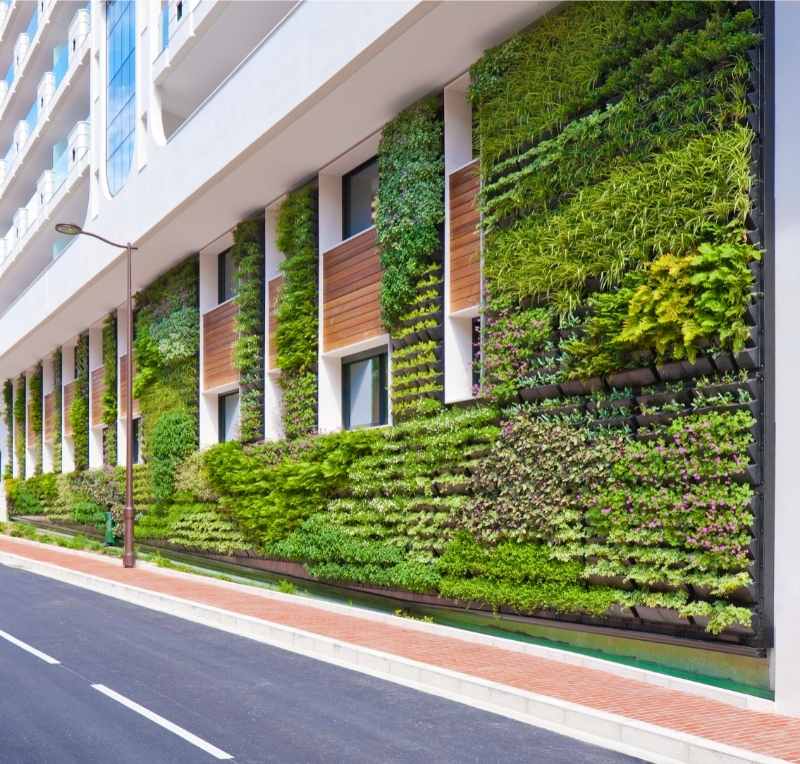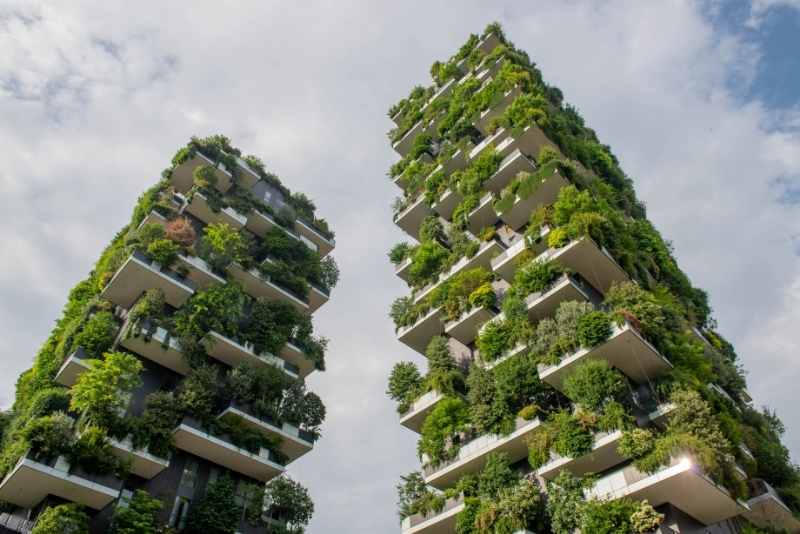Are green walls ecologically sustainable?
As the name might suggest, a green wall brings much more than great aesthetics. Green walls can result in many benefits for the environment, and they are ecologically sustainable.
Green walls encompass a wide range of indoor and outdoor green solutions on vertical structures, including vertical gardens, green facades, stacked plant walls, roof gardens, arbours, and planter boxes with trailing or climbing plants.
Creating a successful green wall solution requires the right design, plant selection and support system. Only when green walls are designed and maintained to be ecologically sustainable will they provide the most benefits to a building and its occupants.
Ecological benefits of green wall solutions

The plants in any green wall solution will help to filter particulate matter, such as dust, pollen, soot and smoke, from the air and convert CO2 to oxygen. Whether it’s an internal or external solution, a green wall will contribute to the purification of the air and improve air quality in and around your building.
Like all plants, the plants in green walls photosynthesize. That means they use sunlight, water and carbon dioxide to produce oxygen and sugars for energy. This process removes harmful carbon dioxide from the air and releases oxygen that we need to breathe.
Cleaning the air
Plants also have a natural ability o clean the air by absorbing pollutants and toxic chemicals. According to Let’s Talk Science, they do this “through the microscopic holes in their leaves called stomata. Microorganisms (very small living creatures) living on and inside of plants can also help clean the air.”
The science is quite remarkable as the microorganisms break down the toxins before releasing them back into the atmosphere in a much less harmful form.

Increases biodiversity
In cities and urban spaces where concrete and asphalt have taken over, a green wall can help bring back the sense of a greener environment. Green walls also attract wildlife to areas where they were previously unable to thrive, including insects, butterflies, bees and birds, which helps to improve the overall biodiversity of the area.
Tackling the urban heat island effect
According to the United States Environmental Protection Agency (EPA), “”Urban heat islands” occur when cities replace natural land cover with dense concentrations of pavement, buildings, and other surfaces that absorb and retain heat. This effect increases energy costs (e.g., for air conditioning), air pollution levels, and heat-related illness and mortality.”
Increasing the number of trees and vegetation can help to reduce the urban heat island effect by shading building surfaces, deflecting radiation from the sun, and releasing moisture into the atmosphere.
In the same way, green wall solutions can help to tackle the urban heat island effect too. By covering the outside of a building with plants in a green wall structure, or adding a roof garden to a building, you are helping to reduce the ambient temperature of the building, both inside and out, helping to reduce the urban heat island effect.

According to Let’s Talk About Science, the lowering of the surrounding air temperature by green walls is done through a process called evapotranspiration. This is a combination of two processes: evaporation and transpiration.
Evaporation is the conversion of liquid water to water vapour. The evaporation of water from the surface of plants’ leaves takes energy from the surrounding environment. Since heat is a form of energy, heat energy will decrease around the green wall. As a result, the temperature goes down.
Transpiration is essentially how plants breathe. Liquid water travels through the plant. It is converted to water vapour as it exits through the stomata in plants’ leaves. Transpiration uses the same principles as evaporation. Converting liquid water to water vapour removes heat from the surroundings. This lowers the overall temperature.
Tests have shown temperature differences of up to 17?C between hard and vegetated surfaces in the same location.
Green credentials
Green walls are visual indicators of sustainable design and can be a means of qualifying for additional eco-credits for sustainability assessment schemes and may help with planning applications.
Building developers are looking at the potential use of green walls for consent purposes when building new developments in urban areas. Usually, a designated amount of green space is required as part of a new development, however, it is possible that green wall solutions, including living walls and roof gardens, could be used as part of the consent process and it is likely that we will see more and more green wall installations in the future as developers look to maximise the use of space whilst providing green space as well as making developments more aesthetically pleasing.
Here at SRS, we are one of the only companies here in New Zealand to offer a full turnkey service when it comes to green walls. From designing and manufacturing all components right through to planting, irrigation, installation and maintaining, we’ve got a green wall solution to meet your needs. Talk to the team today.
